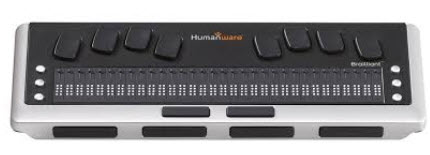A refreshable braille display, also known as a braille terminal, is an electronical device with mechanical components capable of displaying braille characters.
Most refreshable braille displays use round-tipped pins that come up through holes. Being able to display a maximum of 40 or 80 braille cells is common, but in 2015 a full-page display with room for 1,000 braille cells was launched by the Tactisplay Corp. That device displays 25 lines of 40 cells.
 On modern devices, having a speech synthesizer available as an alternative to the mechanical braille display is very common. With such a setup, the user can alternate between reading braille and listening to the voice, or use both systems simultaneously. (For deafblind users however, the mechanical display is the only functional option.)
On modern devices, having a speech synthesizer available as an alternative to the mechanical braille display is very common. With such a setup, the user can alternate between reading braille and listening to the voice, or use both systems simultaneously. (For deafblind users however, the mechanical display is the only functional option.)
Contents
Software
The software capable of controlling the mechanical display on a braille terminal is called a screen reader. The software take the visual information on the screen and convert it into braille characters, before sending it on to the braille display.
Graphical operating system
Graphical operating system can be a bit difficult for screen readers, since graphical components have to be “understood” by the software and described with words that can then be displayed using braille.
Modern operating systems normally have an Application Programming Interface (API) that helps the screen reader with this process.
Examples of commonly used API:s:
- VoiceOver for OS X and iOS
- UI Automation for Windows
- AT-SPI for GNOME
Inpout
Many refreshable braille displays come with an integrated pure braille keyboard consisting of two sets of four keys on each side.
Some models have a conventional QWERTY keyboard for input.
Output
Most refreshable braille displays come with a row of electro-mechanical character cells. Each individual cell can raise or lower a combination of eight round-tipped pins. These pins form the braille characters that can be sensed by the user’s fingers.
The mechanism for raising the dots will typically utilize chrystals and rely on the piezo effect. When a voltage is applied to these chrystals, the piezo effect causes them to expand. As the chrystal expands, it pushes a lever which turns the corresponding pin.
The rotating display
Some models have a rotating display that allows the user to continuously read braille with a stationary finger. One of the earliest versions of this type of refreshable braille display was developed in the end of the 20th century by the National Institute of Standards and Technology (NIST) in the United States. Over in Europe, the Leuven University in Belgium was one of the trailblazors.